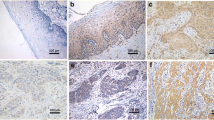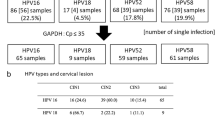Abstract
Objective
Vascular endothelial growth factors (VEGFs) are involved in angiogenesis, but molecular links to the most important etiological agents, human papillomavirus (HPV) and smoking, need to be clarified.
Methods
Archival samples at the first diagnosis of 64 cervical intraepithelial neoplasia grade 1 or 2 (CIN 1/2) lesions were examined immunohistochemically using anti-VEGF-C and anti-Ki-67 antibodies. HPV types were identified from cervical samples by restriction fragment length polymorphism, which has been shown to identify at least 26 types of genital HPVs. Follow-up data were available for all patients with CIN lesions.
Results
Cervical intraepithelial neoplasia lesions regressed in 47 cases and were persistent in 17 cases. Twenty-two smokers, 8 former smokers, and 34 non-smokers were enrolled in the study. The median observation period was 52.3 months. Significantly higher VEGF-C expression was observed in 8 smokers with persistent CIN persistence (49.0 ± 16.6%, P < 0.01), whereas no significant difference was observed in Ki-67 expression. The median time to regression was significantly longer in the 10 smokers with high VEGF-C expression (48.3 months, P = 0.030) than that in the others. HPV was detected in 56 of the 64 cases. Thirty-two patients had high-risk HPV, 13 had intermediate-risk HPV, and 2 had low-risk HPV. No significant difference was observed among the HPV risk groups in both average Ki-67 and VEGF-C expression.
Conclusions
These findings suggest that VEGF-C may play an important role in cigarette smoking-associated cervical carcinogenesis.





Similar content being viewed by others
References
Matsuda T, Marugame T, Kamo KI et al (2011) Cancer incidence and incidence rates in Japan in 2005: based on data from 12 population-based cancer registries in the Monitoring of Cancer Incidence in Japan (MCIJ) project. Jpn J Clin Oncol 41:139–147
IARC (2004) Tobacco smoke and involuntary smoking. IARC monographs on the evaluation of carcinogenic risks to humans, vol 83. IARC, Lyon
Kapeu AS, Luostarinen T, Jellum E et al (2009) Is smoking an independent risk factor for invasive cervical cancer? A nested case–control study within Nordic biobanks. Am J Epidemiol 169:480–488
International Collaboration of Epidemiological Studies of Cervical Cancer, Appleby P, Beral V et al (2006) Carcinoma of the cervix and tobacco smoking: collaborative reanalysis of individual data on 13,541 women with carcinoma of the cervix and 23,017 women without carcinoma of the cervix from 23 epidemiological studies. Int J Cancer 118:1481–1495
Matsumoto K, Oki A, Furuta R et al (2010) Tobacco smoking and regression of low-grade cervical abnormalities. Cancer Sci 101:2065–2073
Matsumoto K, Oki A, Furuta R et al (2011) Predicting the progression of cervical precursor lesions by human papillomavirus genotyping: a prospective cohort study. Int J Cancer 128:2898–2910
Lane D, Gray EA, Mathur RS et al (2005) Up-regulation of vascular endothelial growth factor-C by nicotine in cervical cancer cell lines. Am J Reprod Immunol 53:153–158
Nagano H, Yoshikawa H, Kawana T et al (1996) Association of multiple human papillomavirus types with vulvar neoplasias. J Obstet Gynaecol Res 22:1–8
Mandriota SJ, Jussila L, Jeltsch M et al (2001) Vascular endothelial growth factor-C-mediated lymphangiogenesis promotes tumor metastasis. EMBO J 20:672–682
Obermair A, Bancher-Todesca D, Bilgi S et al (1997) Correlation of vascular endothelial growth factor expression and microvessel density in cervical intraepithelial neoplasia. J Natl Cancer Inst 89:1212–1217
Branca M, Giorgi C, Santini D et al (2006) Aberrant expression of VEGF-C is related to grade of cervical intraepithelial neoplasia (CIN) and high risk HPV, but does not predict virus clearance after treatment of CIN or prognosis of cervical cancer. J Clin Pathol 59:40–47
Van Trappen PO, Steele D, Lowe DG et al (2003) Expression of vascular endothelial growth factor (VEGF)-C and VEGF-D, and their receptor VEGFR-3, during different stages of cervical carcinogenesis. J Pathol 20:544–554
Kapeu AS, Luostarinen T, Jellum E et al (2009) Is smoking an independent risk factor for invasive cervical cancer? A nested case-control study within Nordic biobanks. Am J Epidemiol 169:480–488
Gunnell AS, Tran TN, Torrång A et al (2006) Synergy between cigarette smoking and human papillomavirus type 16 in cervical cancer in situ development. Cancer Epidemiol Biomarkers Prev 15:2141–2147
McCann MF, Irwin DE, Walton LA et al (1992) Nicotine and cotinine in the cervical mucus of smokers, passive smokers, and nonsmokers. Cancer Epidemiol Biomarkers Prev 1:125–129
Prokopczyk B, Cox JE, Hoffmann D et al (1997) Identification of tobacco-specific carcinogen in the cervical mucus of smokers and nonsmokers. J Natl Cancer Inst 89:868–873
Hellberg D, Nilsson S, Haley NJ et al (1998) Smoking and cervical intraepithelial neoplasia: nicotine and cotinine in serum and cervical mucus in smokers and nonsmokers. Am J Obstet Gynecol 158:910–913
Trimble CL, Genkinger JM, Burke AE et al (2005) Active and passive cigarette smoking and the risk of cervical neoplasia. Obstet Gynecol 105:174–181
Berger F, Gage FH, Vijayaraghavan S (1998) Nicotinic receptor-induced apoptotic cell death of hippocampal progenitor cells. J Neurosci 18:6871–6881
Heusch WL, Maneckjee R (1998) Signaling pathways involved in nicotine regulation of apoptosis of human lung cancer cells. Carcinogenesis (Oxf) 19:551–556
Pfeifer GP, Denissenko MF, Olivier M et al (2002) Tobacco smoke carcinogens, DNA damage and p53 mutations in smoking-associated cancers. Oncogene 21:7435–7451
Holmgren L, O’Reilly MS, Folkman J (1995) Dormancy of micrometastases: balanced proliferation and apoptosis in the presence of angiogenesis suppression. Nat Med 1:149–153
Acknowledgments
This work was supported by grants-in-aid for scientific research projects on smoking and health from the Smoking Research Foundation of Japan.
Conflict of interest
No author has any conflict of interest.
Author information
Authors and Affiliations
Corresponding author
About this article
Cite this article
Inamine, M., Nagai, Y., Mitsuhashi, A. et al. Cigarette smoke stimulates VEGF-C expression in cervical intraepithelial neoplasia (CIN) 1 and 2 lesions. Int J Clin Oncol 17, 498–504 (2012). https://doi.org/10.1007/s10147-011-0322-3
Received:
Accepted:
Published:
Issue Date:
DOI: https://doi.org/10.1007/s10147-011-0322-3




